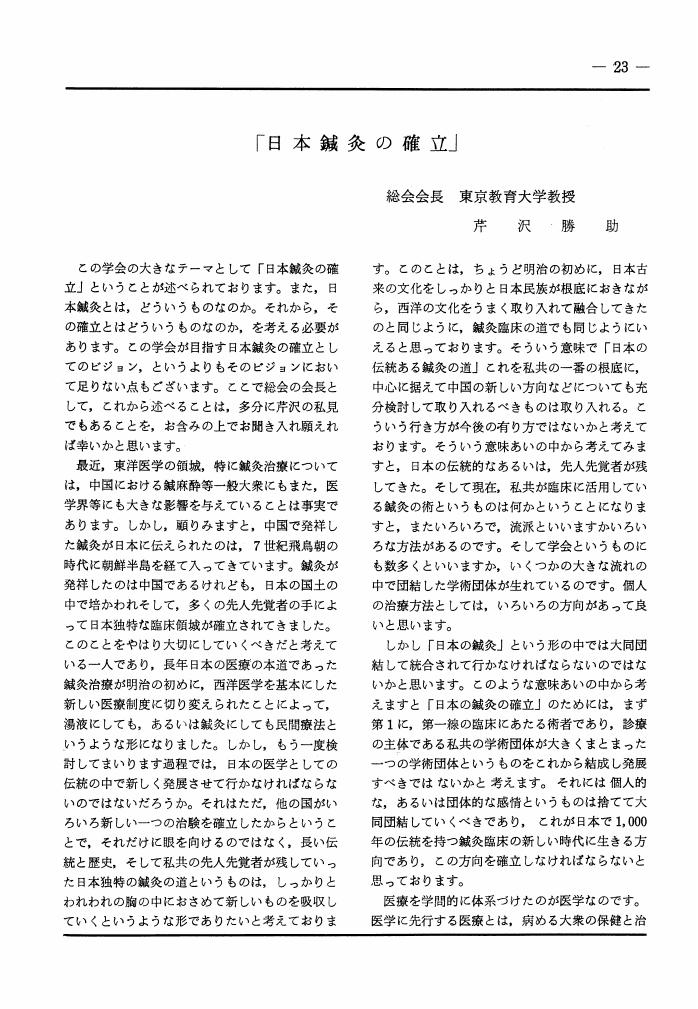3 0 0 0 OA 日本鍼灸の確立
- 著者
- 芹沢 勝助
- 出版者
- 公益社団法人 全日本鍼灸学会
- 雑誌
- 自律神経雑誌 (ISSN:03870952)
- 巻号頁・発行日
- vol.22, no.1, pp.23-25, 1975-02-01 (Released:2011-05-30)
2 0 0 0 OA 聞診の客観化
- 著者
- 森 和 芹沢 勝助 秋山 和儀
- 出版者
- The Japan Society for Oriental Medicine
- 雑誌
- 日本東洋醫學會誌 (ISSN:1884202X)
- 巻号頁・発行日
- vol.27, no.2, pp.70-80, 1976-11-30 (Released:2010-10-21)
- 参考文献数
- 18
1 0 0 0 OA 望診の客観化
- 著者
- 森 和 矢野 忠 芹沢 勝助
- 出版者
- The Japan Society for Oriental Medicine
- 雑誌
- 日本東洋醫學會誌 (ISSN:1884202X)
- 巻号頁・発行日
- vol.27, no.1, pp.125-138, 1976-08-30 (Released:2010-10-21)
- 参考文献数
- 31
1 0 0 0 OA 経絡, 経穴の医学的研究
- 著者
- 芹沢 勝助
- 出版者
- 一般社団法人 日本温泉気候物理医学会
- 雑誌
- 日本温泉気候学会雑誌 (ISSN:03694240)
- 巻号頁・発行日
- vol.24, no.4, pp.389-459, 1960 (Released:2010-08-06)
- 参考文献数
- 53
The ideas of “Keiraku” and “Keiketsu” are fundamental principle in acupuncture and moxibustion which have been developed in the East since ancient times. The system of “Keiraku” derives from a philosophical idea of the East and is the result of analysis and synthesis of many years experiences by Chinese medical men. “Keiraku” are the lines of reaction points, while “Keiketsu” are the points on “Keiraku” determined upon human body surface where therapeutic stimuli are to apply.“Keiraku” and “Keiketsu” are functional reaction zone and points, which are projected upon the surface of the body corresponding to the disorders of the internal organs. They are supposed to be located not only planely upon the skin but also expand three-dimensionally so deeply as far as into the subcutaneous tissues. It has been scarcely discussed, whether they should really exist or not, and whether they might have or not such special meaning as is believed in the field of practical therapists.In order to clarify the special characters of “Keiraku” and “Keiketsu” the author measured the cutaneous electric resistance in relation to the changes of the superficial structure of the skin and detected subcutaneous induration objectively with a massagekymograph corresponding to the changes in the deeper structure. And then the existence of “Keiraku” and “Keiketsu” was discussed through experimental researches and consequently following results were obtained:To measure the electric resistance of a minute area of the skin an apparatus with a small sharp electric pole, devised by Professor Ishikawa of the Kanazawa University, was used and the distribution of the cutaneous points with markedly decreased electric resistance was investigated in healthy and diseased subjects.It was revealed that there are several localized spots on the skin (with dimension of about 1×1mm2) which showed a distinguished decrease in the electric resistance. In some cases these “points of decreased cutaneous electric resistance” (P. d. c. e. r.) coincided with the sites of “Keiketsu”. The relative values of electric resistance at these points and the surrounding skin area are about one to hundred.And these P. d. c. e. r. changed their sites and degree of decrease by hours, clays, and weeks. Namely they showed daily or weekly changes in their distribution and character.In the dorsal region of 3 cases out of 5 subjects (60%) the zone of P. d. c. e. r. appeared paravertebrally 4cm both sides of the spinal column and on the middle line between the proc. spinosi. In 4 out of the 5 cases groupings of the P. d. c. e. r. were recognized between the mammae, in the mesogastric area, hvpochondrium, and on the abdominal middle line. This finding corresponds with “Keiraku” (reflected line) of “Yu” points and “Bo” points which are highly estimated in the diagnostic examination on dorsal and ventral regions in the Eastern Medicine.In 85 cases of healthy subjects it was discovered that the distribution of the P. d. c. e. r. appeared densely in the neck, upper abdominal regions, hypochondrium, loins, and cubital regions. This dense distribution of the P. d. c. e. r. coincides also with clinically important “Keiketsu” (reflected or reaction point) in the Eastern Medicine. And in these areas a dense distribution of the subcutaneous indurated nodules was detected too. The distribution of the P. d. c. e. r. on the upper and lower limbs indicated the existence of longitudinally line shaping distribution of reaction points, e. g. “Keiraku”. Especially in 9 cases of 85 subjects a distribution of P. d. c. e. r. was found which closely resembles with “Keiraku” and “Keiketsu”.Throughout the whole experiments th


